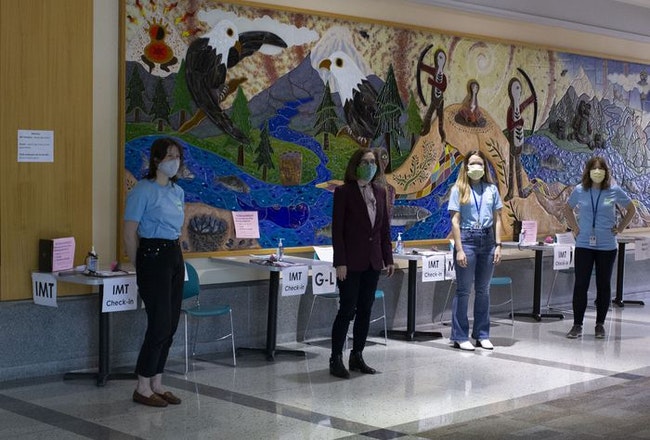 Oregon Governor Kate Brown held a press conference Friday laying out her COVID-19 containment strategy for the state and plans for reopening. May 1, 2020 Beth Nakamura/Oregonian/Oregonlive
Oregon Governor Kate Brown held a press conference Friday laying out her COVID-19 containment strategy for the state and plans for reopening. May 1, 2020 Beth Nakamura/Oregonian/Oregonlive
Coronavirus resources: CDC on the coronavirus, Oregon Health Authority resources, Washington County resources, Oregonian reporting on the coronavirus, OPB glossary of coronavirus terms, NYTimes free reporting on the coronavirus.
This article was originally published by the Oregonian/OregonLive, one of more than a dozen news organizations throughout the state sharing their coverage of the novel coronavirus outbreak to help inform Oregonians about this evolving health issue.
Oregon Gov. Kate Brown unveiled a bevy of new initiatives and details Friday to beef up testing and contact tracing as businesses look to reopen amid the coronavirus pandemic.
Brown announced a new “game changer” partnership with Oregon Health & Science University to monitor 100,000 Oregonians for coronavirus symptoms over a year, providing serial testing for up to 10,000 of those voluntary participants with the goal of spotting infections early among people without symptoms.
The state also disclosed an agreement between six hospital systems to coordinate test and lab capacity to ensure adequate testing in areas with unmet needs. And the health authority for the first time began encouraging coronavirus testing for anyone with mild symptoms.
The announcements came as state officials attempt to balance the desire to restart the economy against the threat of more deaths, suggesting that risks can be managed by adding 600 people to perform public health investigations and ensuring 15,000 Oregonians can be tested for the virus each week.
Brown said she’s “relatively optimistic” that the state can meet its goals and stressed the importance of a methodical approach based on science and data in reopening parts of the economy.
Some rural counties or regions could begin reopening as soon as May 15, although the timeline for the Portland metro area is unclear.
“We can’t stand still,” Brown said, adding: “It’s really important that we take gradual and incremental steps forward.”
Oregon has not seen a high rate of coronavirus infections compared to the rest of the nation, identifying nearly 2,600 residents with the virus through limited testing and 104 deaths. Yet officials are taking a more cautious approach to reopening than in some other states, such as Georgia, which began easing stay-home restrictions last week. Some Oregonians are pressing to reopen businesses and resume a variation of daily life, with already more than 360,000 residents reporting job losses.
Dr. Dean Sidelinger, the state health officer and epidemiologist, said he’s confident Oregon’s plan will allow businesses to gradually reopen while preventing a dramatic surge in coronavirus infections.
“We’re not going to be able to prevent every case,” he told The Oregonian/OregonLive in an interview before Brown’s morning news conference. “And I think we will see cases increase as people start to move about more.
“But we feel this is a plan where we can best manage that and try to keep the increase in cases to a minimum.”
Yet new modeling shows that easing restrictions runs the risk of sharply increasing infections in Oregon because the novel coronavirus is so easily spread, particularly among people without symptoms. The modeling suggests that Brown’s March stay-home order reduced infections by about 70 percent from what it could have been – and doing anything different creates uncertainty.
If future restrictions reduced infections by only 60 percent, Oregon might see just modest increases in active infections and deaths, the modeling suggests. But at 50 percent, active infections could jump quickly and a greater number of deaths could ultimately follow, the modeling suggests.
Oregon could manage under one scenario but “the curve does rise rather steeply” in the other, Sidelinger said.
“The problem is, we’re a little hampered in knowing exactly how much decrease in transmission we can do with these measures,” he said of Oregon’s reopening plans.
Despite that uncertainty, Sidelinger said he believes Oregon can reopen safely while officials aggressively monitor infections and hospitalizations to determine if coronavirus spreads too rapidly.
“I’m confident that we can keep it at 60 percent,” he said. “And if we’re seeing increases, then we will roll out easing of measures.”
Brown said such rollbacks will be used if necessary but she hopes Oregon can progress through a three-phase reopening plan.
“Obviously by proceeding cautiously and carefully and incrementally,” she said, “we’re hoping to not have to take steps backward.”
Oregon’s ability to expand and better coordinate testing will play an important role going forward.
OHSU beginning May 11 will send letters to selected households across Oregon seeking 100,000 volunteers to participate in a yearlong study to track symptoms. People who develop coronavirus symptoms will be prioritized to receive an in-home test kit, and the study also plans to offer regular testing for up to 10,000 people without symptoms to spot any silent spread of the virus.
The study will include an oversampling of communities of color, which so far have been hard hit by the pandemic. Data will be shared weekly with the Oregon Health Authority so the agency can distribute numbers to the public.
“We believe this study will provide valuable, critically important baseline data about the virus in Oregon and how it behaves,” said Dr. Danny Jacobs, the president of OHSU.
The state also announced a coordinated approach between several hospital systems in the Portland area, southern Oregon and Bend to ensure testing is available throughout the state. Those hospitals will partner with smaller hospitals in rural areas.
“In this approach, testing capacity will be managed not as six separate hospitals but as one statewide system that will allocate resources to meet the state’s needs in every region of the state,” Brown said.
The Oregon Health Authority also Friday revised its guidance to recommend testing anyone with coronavirus symptoms. The change came nine weeks to the day that Oregon identified its first coronavirus infection. Other states have already promoted broader testing.
“Testing should be available for any Oregonian showing symptoms of the coronavirus,” Brown said. “If you are displaying known signs of the virus, you should be able to be tested, period.”
State officials also adopted guidance previously announced by the Centers for Disease Control and Prevention that broadens the list of symptoms for testing. The Oregon Health Authority earlier this week had declined to answer questions from the newsroom about bolstering the list.
The new guidance says symptoms include fever, cough or shortness of breath, or two of the following: fever, chills, repeated shaking with chills, muscle pain, headache, sore throat, or new loss of taste or smell.
Documents released Friday provided new details about how state officials arrived at their goal of being able to test 15,000 Oregonians a week.
The state has assumed that at any given time 2,800 Oregonians are infected with the virus. Dividing that number by eight days, the assumption for how long each person is infectious, the state believes 350 people are infected each day.
The state wants to have testing capacity so each new infection could ensure the testing of five people. That would require a total of 1,750 a day, or 12,250 a week, according to the state. Officials also want to perform targeted testing for outbreaks and broader surveillance, taking the total to 15,000.
No state is conducting widespread testing because of limitations in supplies. But Oregon’s plan would allow for testing of less than 0.5% of the population each week, below the level many experts say is needed.
“In a month from now, we’ll probably be talking about a higher goal,” Sidelinger said.
State officials provided new but limited details on their plan to ensure 600 more people are hired to perform contact tracing. Tracers would talk with infected Oregonians, identifying who they could have infected and notifying those people to stay home to prevent spread for 14 days from their date of exposure.
The health authority said Oregon has at least 100 tracers now. Officials plan to add 600 more workers for tracing based on a projections of 15 workers for every 100,000 residents.
But national health organizations have said that ratio should be a baseline and during this pandemic it should be twice as high. That would suggest an appropriate number of more than 1,300 tracers in Oregon.
Asked whether 600 new tracers is sufficient, Sidelinger said: “This is where we’re going to start. We’ll continue to evaluate to see how we’re doing.”
Tracers would be hired over the next month or so. Each tracer would be responsible for contacting 15 people at any given time, Sidelinger said, noting that many of them may be new to public health investigations and workloads will be monitored.
Oregon’s tracing plan would generally offer testing only to people who had been exposed and who were subsequently experiencing coronavirus symptoms. Pressed Friday why the state isn’t also calling for testing of people who have been exposed but don’t have symptoms, Sidelinger said: “Our recommendations may evolve.”
Brown said she planned to hold a conference call later in the day with some rural Oregon counties that have expressed the most eagerness to reopen. She said some have already submitted plans to her office detailing their efforts to prepare.
As for when the Portland area could reopen? Oregon’s governor said detailed criteria are in the works.
“We’ll be releasing those details soon,” she said.




